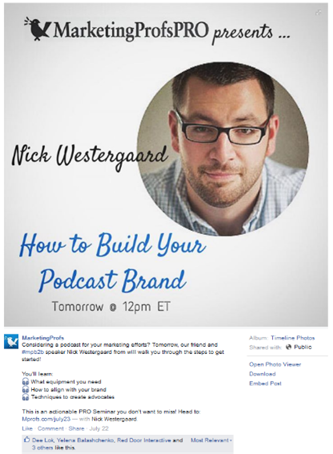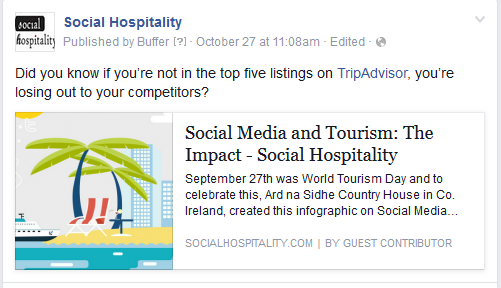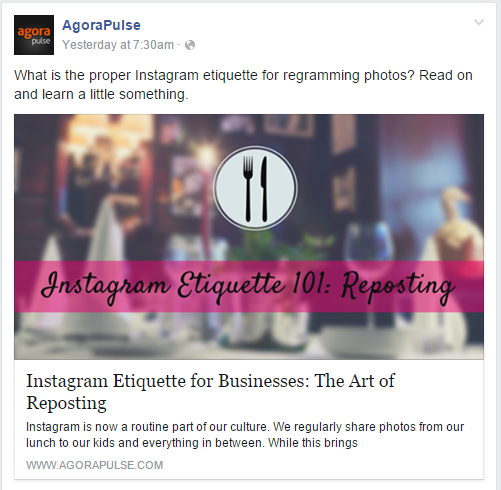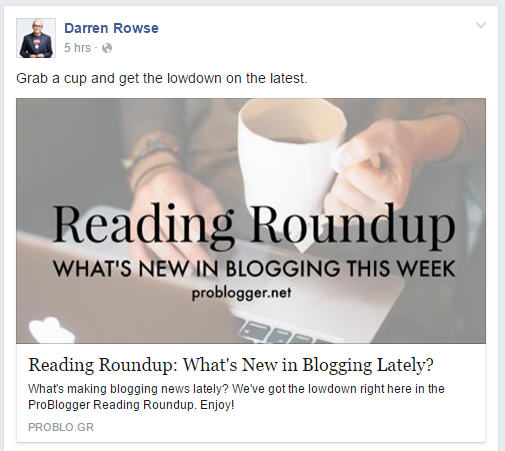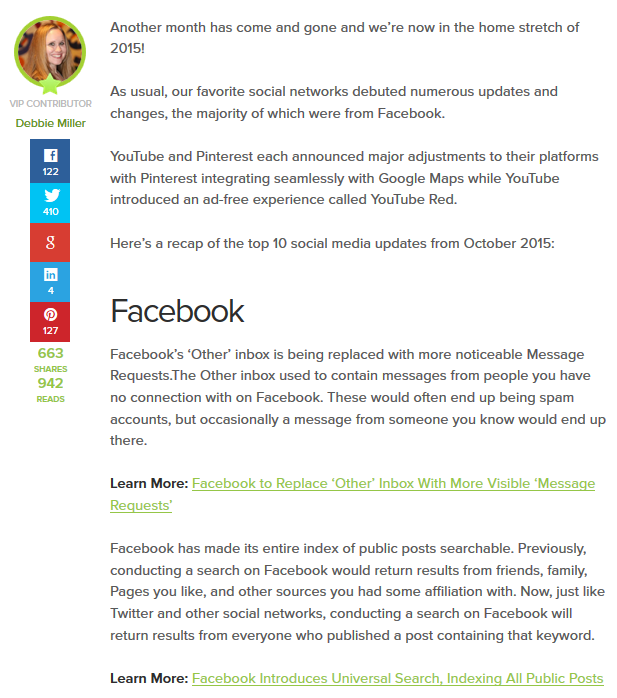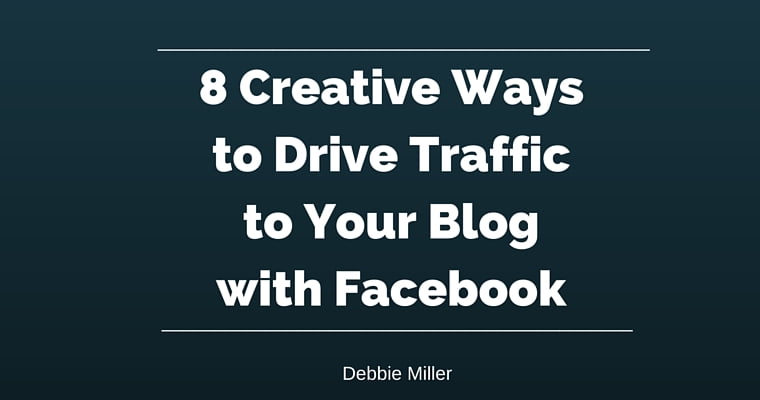

You’re doing everything you can to drive traffic to your blog. You’re emailing your subscribers. You’re using Facebook to disseminate content.
The problem is, with so much happening on Facebook, how do you capture your audience’s attention among all the noise?
Beyond posting when a new article goes live, what are the other ways to utilize Facebook for greater traction?
Here are eight creative ways to drive traffic to your blog with Facebook.
1. Vary Your Types of Posts
When you’re sharing content from your blog on a regular basis, it can be easy to slip into a habit of crafting all posts in the exact same manner.
Play around with wording posts in different ways and see which resonates most with your audience.
You can experiment with utilizing simple, direct statements that leave the reader wanting to learn more about what you’ve introduced, or you can provide a bit more detail in your posts to highlight the main takeaways of your content.
Monitor your analytics and see what types of posts garner the most engagement and clicks, then stick with that when posting the majority of your posts in the future.
One blog that provides a nice snapshot of diversifying post types isMarketingProfs. I’ll dive in greater detail into many of the tactics they employ later in this article, too.
In addition to regularly sharing their latest articles, they also do a lot of posts containing photos rather than links. Not only do they share photos, but they custom-make one aligned to their brand.
For example, for a recent podcast episode, rather than simply saying, “Don’t miss our podcast,” they instead opened the post as a question (we’ll get to this more in a minute!) and used the headphone emoji to relay further details. This helped break the post up and not fall into the abyss of clunky text.
Furthermore, they used a custom graphic (we’ll get to this later, too!) featuring their own branding at the top, a photo of the presenter, and the date and time of the podcast. This will resonate more with an audience than a basic stock photo of a microphone would.
MarketingProfs has also featured videos in their feed (we’ll cover this as well!). As video is one of the post types with the highest organic reach on Facebook, uploading videos to your feed is highly beneficial.
This provides an opportunity to have some fun, too. MarketingProfs did a video with speakers reading mean marketing tweets.
2. Use Different Types of Questions
A common tactic employed by bloggers and brands alike is to ask questions. But, what kind of questions should you ask? There are a variety of ways to position questions to grab your readers’ attention.
Here are a few examples:
For a blog post surrounding the impact of social sites on tourism, Social Hospitality teased the question, “Did you know if you’re not in the top five listings on TripAdvisor, you’re losing out to your competitors?”
This entices the hospitality-focused reader to think about their own situation and consider how their property ranks on TripAdvisor. This is an example of a direct post (as noted above) which leaves the reader wanting to know more.
Convince & Convert recently presented a different kind of question to promote one of their posts. A metaphorical, hypothetical question. This applies a new connotation to the content of the blog post, allowing the reader to think about it in a new way, and want to learn more about this solution being proposed by the post’s question.
Another option is to essentially poll your audience – ask their feedback on something to get their wheels turning, then provide solutions in the blog post you’re sharing. Search Engine Journal utilized this tactic in the above example to encourage people to click through and learn about ways to humanize their brand.
3. Interact with Other Pages on Facebook
Similarly to how you can interact with business pages when using Facebook as yourself, you can also use Facebook as your page. If you go to the small arrow at the top-right of the blue Facebook header bar, the first option when you click is to “Use Facebook as:” then a list of the pages you manage. Once you select a page, you’ll be using Facebook as that particular page.
Initially, you’ll land on your fan page itself, but once you click the Facebook icon in the top left corner, you’ll return to a timeline view of the pages you follow. If you haven’t followed any yet, now is a great time to start!
Simply search for pages as you would normally, and “Like” them. Once you’ve liked a number of pages, they’ll appear in your page’s News Feed, allowing you to follow their posts, then “Like” and comment on them accordingly.
Wondering what pages to like? I recommend following anything related to your blog/brand/product/service or anything relevant to your target audience. There are numerous benefits to doing this. First, it puts you in front of theiraudience. And if you have the same audience, that’s a win, because you’re reaching potentially new readers.
It also shows support for other blogs and businesses, which can assist in nurturing new relationships and creating possible partnership opportunities. This stimulates additional growth potentially beyond Facebook itself.
By expanding the audience of your Facebook page, you can thereby use the other tactics mentioned when posting to drive those new fans back to your site and convert them to blog fans as well.
Monitor your Facebook insights and consider running “new fan” promotions on days you see your number of likes spike. Perhaps create a page on your blog dedicated to new fans and offer some sort of incentive for them to subscribe to your articles.
If your blog offers any additional elements (such as an e-book, podcast, etc.), provide a free sample to new audience members so they can learn more about you. Share this on Facebook for additional leverage.
4. Use Excerpts as Quotes
This is a great way to re-share the same article on Facebook multiple times without it being too transparent.
If you have a large enough following, using quotes to create engagement, and thus, ultimately, reach and clicks is crucial. Be sure to build up a strong following first before progressing with playing with post types for traffic.
It’s difficult to pinpoint a one-size-fits-all answer to the ideal number of followers, but if you can get a reasonable amount engaged with your Facebook, that’ll help get your posts in front of their connections, which should eventually grow both your organic reach and subsequent traffic back to your blog.
By pulling various excerpts from your article and quoting them, you can diversify the messaging of your blog posts which may assist in reaching people with various interests, too.
A great way to select quotes to use for your post is to locate the ones that speak to you readers’ needs. For example, the Jeff Bezos quote above, excerpted from HubSpot’s guide to developing a strong corporate brand identity, speaks to a specific struggle readers may endure, and thus, it provides a fitting introduction to the following question as well as the article.
Another option is to take this to the next level and create a visual depiction of a specific quote.
AgoraPulse does a nice job of creating custom visuals to accommodate their posts, featuring an element from the article, the post title itself, or some other line that speaks to the heart of the article:
Canva is an excellent tool for creating custom images for Facebook posts in a short amount of time.
5. Do Regular Recaps of Blog Posts
An additional tactic to obtain some additional leverage from your blog posts is to do recaps on your blog then re-share those recaps as Facebook posts.
Recaps can come in a variety of forms: they can be done by date range (i.e. weekly or monthly) or they can also be bundled by genre (i.e. the latest posts on social media, SEO, content marketing, etc).
These are many benefits to doing this. First, it creates a basecamp for people to gain a comprehensive view of the latest news surrounding a specific topic.
Next, it provides an excuse for you to link back to your previous posts, thereby leveraging content that may have otherwise dried up.
Darren Rowse’s popular blog, ProBlogger, does a weekly roundup of blogging posts from various sources and shares on their Facebook page: The same can be done with posts on your own blog as well.
Another example is a monthly social media recap I do for Search Engine Journal. At the beginning of each month, I aggregate social media news from the previous month and consolidate it into a single post on SEJ, broken up by channel:
Now, not only does SEJ get traffic from the original posts featured in the recap, but it also brings additional eyes to the site by sharing this post to Facebook each month as well.

6. Create Video Recaps of Posts
This is somewhat similar to podcasting, but with the rise of Facebook video, it’s worth taking advantage of this new opportunity. Create a video recap of your blogpost and link to it from the Facebook video when you post it.
This is perfect for your audience members that may be swamped during the day and don’t necessarily have time to read through various blogposts, but they may be able to listen to something in the background while they’re working.
ProBlogger posts a lot of Facebook videos about blogging and other related topics to their blog content.
Conversely, you can also do a video series about something and then create blog post recaps of your videos, and embed them, creating a nice array of cross-pollination.
For example, HubSpot has a hefty variety of “How To” videos on Facebook that revolve around concepts they also cover in their blog.
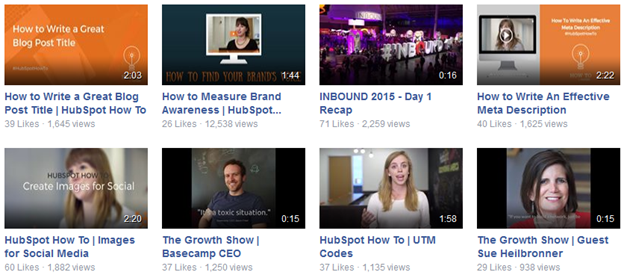
By posting videos on your Facebook page, this helps increase your Facebook reach as studies show videos posted to Facebook have the highest organic reach.
The best ways to draw people back to your site from your videos include:
- Including a call-to-action at the end of the video that entices people to visit your blog for more information.
- Teasing elements of your articles in the video then encouraging viewers to read blog posts for additional input.
- Transcribe your videos into blog posts themselves – increase the longevity of your expertise by showcasing it in different manners.
7. Optimize Posts for SEO
Did you know Facebook posts can show up in Google Search results? Another useful strategy for garnering additional traffic from your Facebook posts is to optimize your post content for Search Engine Optimization (SEO).
What this means is think about phrases people might search for in a search engine that would bring people to your blog, and inject those keywords into your posts introductions on Facebook.
Have your Facebook post phrasing contain the primary terms for which you’d want your post to be found. That way, your post itself can potentially come up in results for the various keywords it contains, and your Facebook posts can potentially come up as well, thereby driving traffic to both your Facebook and the blog post.
The key to injecting keywords into your Facebook post introductions is to do it naturally. There’s nothing worse than keyword-stuffed posts that are a clear SEO ploy. Find that middle ground of having your text be optimized both for readers as well as search engines.
Here is a great example from Search Engine Land:
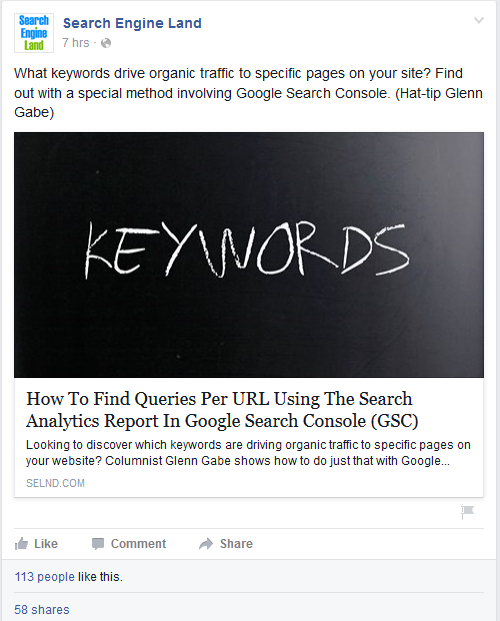
Not only have they utilized a question to entice their fans to click on the link, but the phrase “what keywords drive organic traffic” is a highly searched phrase. In fact, in August, there were 275,000 searches for related topics.
Many articles themselves contain noteworthy phrases that are also SEO-efficient.
In this post, the keyword phrase is “social media guidelines,” a topic about which many are looking for guidance. By utilizing this particular phrase in the post content itself, HyperDisk Marketing’s post may potentially rank in search results, thereby bringing additional eyes to both the Facebook page as well as the article when people click-through to it.
8. Take Advantage of Boosted Posts
Boosting posts is one form of Facebook advertising that allows you to boost one post’s specific content (rather than having to create a distinct right-rail ad) to a select audience.
The beauty of Facebook’s ad targeting is that you can boost posts to a direct, custom audience. Boosting posts is relatively simple, too. Any admin of a Facebook page can boost a post by clicking on “Boost Post” in the lower-right corner:

Then, you have the option to choose targeting, budget, and duration. This is where you have the opportunity be strategic and creative with whom you target. You can target friends specifically, friends of those who already like your page, or a new audience of your selection.
You can create audiences of your precise audience/customer and target content to them as well. For example, in the above post that relates to customer relationships, I could target it toward those who like pages of other brands that also focus on customer relationships.
Employing Facebook’s “lookalike audiences” can be useful as well. This would allow you to upload your current blog subscriber list into Facebook. It would match the email addresses of the individuals uploaded with their Facebook profiles.
From there, it would analyze those peoples’ Facebook presence (their behaviors, pages they like, etc.) and create for you a custom audience that aligns closely with the folks that already like your blog.
Are You Ready to Drive More Traffic to Your Blog from Facebook?
It may seem scary or intimidating to put so much thought into the different ways to formulate and re-purpose blog posts for Facebook.
Whether you’re considering utilizing quotes or questions, videos or recaps, these are all stepping-stones to enhance your Facebook footprint and drive traffic back to your website.
By following the steps above, you’ll be well on your way to upping your traffic from Facebook in no time!
[“source-searchenginejournal”]
